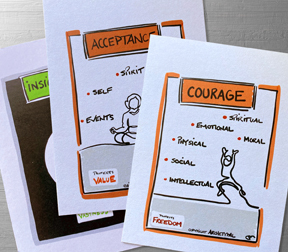A unique course teaches you how to make better decisions and minimize risk.
Right until the snow starts to slide we are partying. It’s a weekday and we’re six dads playing hooky to shred knee-deep powder in the Vancouver Island backcountry. On our first run we expect the new snow to be touchy in spots, but after careful testing and ski cutting nothing moves. Excited to move, we shrug, embrace the stability and party-lap the rest of the run: figure-eighting, cutting each other off and generally goofing around.
Our carefree attitude sticks around for lap two. Like teens pushing each other into dumpsters, we approach Bucks Run like we’re indestructible. When I stop at the top, Andrew plows right by me with a devilish, I’m-stealing-your-line smile. And then Mother Nature slaps it right off his face. The slope fractures under his skis and he’s instantly out of control, caught in an avalanche.
It isn’t a big slide but it still manages to submerge him and then push him right into a group of bone-breaking trees. As I watch, breath held, he somehow threads between the trunks, avoiding injury or worse, and emerges shaken, chastised, but unhurt.
I’ve remembered that accident many times, but I never really thought about why it happened until the first session of Ken Wylie’s Adventure Risk Management Course. While most avalanche courses acknowledge that human factors and decision-making are significant contributors to almost every avalanche accident, Wylie’s course is one of the few that focuses on how to make better decisions in risky environments.
“We’re playing with fire if we go into environments that can kill us and we don’t prepare for that,” says Wylie. “Being aware of your decision-making process and how to evolve your choices is a crucial component.”
The 50-something Wylie has plenty of experience to draw from. A fully qualified IFMGA mountain guide, he’s been skiing and climbing for more than 40 years. The most formative experience was a major avalanche accident in 2003. Wylie was one of two mountain guides when a size-3 slide buried him and 13 of their clients—seven of whom died. Wylie has had the weight of responsibility on his shoulders since. And he spent a decade trying to understand all the decisions he’d made that led up to the accident and wrote about the process in his 2014 book Buried.
His unique course focuses on eight, two-sided cards. The light sides of each card are universal values that Wylie says exist in cultures around the world. Flipping the card over reveals the shadow opposite, decision-making dragons or biases. They are: acceptance/denial, courage/fainthearted, connection/isolation, self-awareness/insignificance, intuition/intellectualizing, truth/deception, grace/hubris and peace/chaos.

Wylie still personally carries them with him in the backcountry and flips through them or lays them out when making decisions or at transitions.
“The cards are something tactile,” he explains. “They also build on each other. You can see the trajectory of your decisions and actions.”
If you accept that the avalanche danger is higher than expected, it’s easier for someone to have the courage to suggest a different objective, which leads to everyone feeling connected and honest with their abilities and desires, making decisions with intuition and truth, which leads to grace and a feeling of peace. The chain is even more obvious on the shadow side of each card.
Wylie originally developed the course as an in-person, intensive retreat, but the pandemic forced him to tweak it for Zoom. Every week I virtually met with Wylie and six other students in their 20s to 50s. The first two-hour lesson was an introduction and overview. Each subsequent session focused on two cards, starting with what the terms meant, anecdotes about how they prevent or contribute to accidents, discussions and exercises.
With each card I recognized blind spots in my own near misses, mishaps and minor accidents. I thought about the time I pushed for a summit despite a difficult time limit, rationalizing, or as Wylie’s card states, intellectualizing how we could catch up on the descent. Of course we were late, and because of that we had to rush (often another contributor in accidents) and also worried our wives. Or the time my ego pushed me to keep up with a new friend. We dusted another member of our group, making him feel isolated, so he didn’t feel valued enough to contribute to our snow-stability evaluation. We ended up kicking off a slide. Thinking back now, I’m certain with our slower-climbing friend’s input we would have made a better decision.
And there was Andrew’s slide on Bucks Run. Caught up in the group’s energy, we lost connection to the place we were in. We denied the obvious signs and let non-event feedback—nothing bad happened so far, so it must be safe—cloud our intuition. We ignored the truth, deceiving ourselves and letting hubris loose. It all led to the avalanche and chaos.
After the course, I’ve noticed I approach the backcountry in a more thoughtful way. This includes spending more time considering who I’m skiing with and what their biases might be. At every critical decision I dig a little deeper to understand the heuristics at play. Now, it seems, when I go backcountry skiing, or participate in any risky activity, I’m learning more about myself.
And to Wylie that’s the true value of his course.
“We’re no service to society if we go out skiing just to be adolescent,” he says. “The evolution of adventuring in the mountains is to better understand who we are and come back a better person.”
More on Ken Wylie’s Adventure Risk Management course at archetypal.ca; or learn hands-on by hiring him as a guide for your next adventure.



